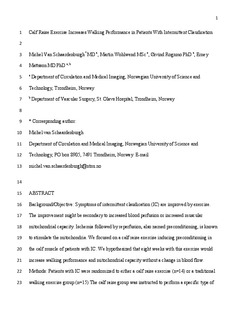| dc.contributor.author | van Schaardenburgh, Michel | |
| dc.contributor.author | Wohlwend, Martin Rainer | |
| dc.contributor.author | Rognmo, Øivind | |
| dc.contributor.author | Mattsson, Erney | |
| dc.date.accessioned | 2017-04-05T08:08:48Z | |
| dc.date.available | 2017-04-05T08:08:48Z | |
| dc.date.created | 2017-01-24T10:23:07Z | |
| dc.date.issued | 2017 | |
| dc.identifier.issn | 0741-5214 | |
| dc.identifier.uri | http://hdl.handle.net/11250/2436792 | |
| dc.description.abstract | BACKGROUND:
Symptoms of intermittent claudication (IC) are improved by exercise. The improvement might be secondary to increased blood perfusion or increased muscle mitochondrial capacity. Ischemia followed by reperfusion, also named preconditioning, is known to stimulate the mitochondria. We focused on a calf raise exercise inducing preconditioning in the calf muscle of patients with IC. We hypothesized that 8 weeks of this exercise would increase walking performance and mitochondrial capacity without a change in blood flow.
METHODS:
Patients with IC were randomized to either a calf raise exercise group (n = 14) or a traditional walking exercise group (n = 15). The calf raise group was instructed to perform a specific type of calf raise exercise three times a day. The walking group was instructed to walk near the pain threshold at least 30 minutes three times a week. Both interventions lasted 8 weeks and were not supervised. Measurements of walking performance, mitochondrial capacity, peak oxygen uptake, peripheral hemodynamics, and health-related quality of life were obtained on each patient before and after the intervention period. Adherence was measured by a training diary, and an activity monitor was used.
RESULTS:
The calf raise group improved pain-free walking distance by 44 meters (P = .04) and maximal walking distance by 99 meters (P = .047). Furthermore, claudication onset time increased by 123 seconds (P = .02), and peak walking time increased by 104 seconds (P = .01). The calf raise group increased the enzyme citrate synthase activity, which is a biomarker of mitochondrial volume-density in the muscle tissue (P = .02). The walking group did not increase any of these variables. Maximal blood flow, peak oxygen uptake, and mitochondrial respiration did not change in any group. The calf raise group experienced less disease anxiety (P < .01). Adherence to the instruction of exercise was 100% in the calf raise group and 80% in the walking group. The calf raise group maintained physical activity. A reduction in activity (P < .01) was found in the walking group.
CONCLUSIONS:
Calf raise exercise improves walking performance and increases mitochondrial volume-density in the gastrocnemius muscle without increasing blood flow in patients with IC. | nb_NO |
| dc.language.iso | eng | nb_NO |
| dc.publisher | Elsevier | nb_NO |
| dc.title | Calf Raise Exercise Training Increases Walking Performance in Patients With Intermittent Claudication | nb_NO |
| dc.type | Journal article | nb_NO |
| dc.type | Peer reviewed | nb_NO |
| dc.source.journal | Journal of Vascular Surgery | nb_NO |
| dc.identifier.doi | 10.1016/j.jvs.2016.12.106 | |
| dc.identifier.cristin | 1436173 | |
| dc.description.localcode | This is the authors manuscript to the article (preprint). | nb_NO |
| cristin.unitcode | 194,65,25,0 | |
| cristin.unitname | Institutt for sirkulasjon og bildediagnostikk | |
| cristin.ispublished | false | |
| cristin.fulltext | preprint | |
| cristin.qualitycode | 1 | |
